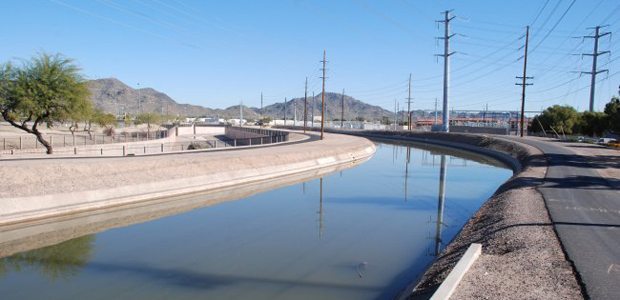Salt River Project begins its annual winter canal dry-up schedule later this week when portions of the South, Consolidated, Eastern, Tempe, Western and Highline canals on the south side of the Salt River will be drained for annual maintenance and construction activities.
The 2013 southside dry-up marks the second year of a seven-year canal dry-up plan, which will potentially result in increased construction traffic on canal banks as SRP crews work to remove silt, replace concrete lining and repair gates.
The southside dry-up will take place from Friday through Dec. 22, with the herding and relocation of the weed-eating white amur fish likely to last the first seven to 10 days. Many of SRP’s southside irrigation customers will not receive water from the canals during the dry-up. The affected areas include Mesa, Tempe, Gilbert, Chandler and south Phoenix.
This dry-up, SRP construction crews will be working primarily in a 10-mile stretch of the Consolidated Canal between Broadway Road and Queen Creek Road, where they’ll be removing silt and debris before starting the process of repairing and replacing the canal lining.
Also, SRP crews again will use the southside dry-up to examine the canals and underwater structures to look for evidence of invasive adult quagga mussels. The mussels were discovered in SRP’s canal system for the first time in July during a routine inspection, although both locations were in canals on the north side of the Salt River.
The ambitious rotational plan was implemented to dry-up each canal segment once every seven years. The rotation was built around the time constraints of relocating fish and completing all maintenance activities for a given canal reach. Before implementing the plan, city water treatment plant operators provided feedback on the proposed schedule.
Prior to the introduction of the white amur fish used to control aquatic vegetation in the canals, SRP would close the head gates and drain the entire canal system to allow for inspection, maintenance and construction activities. When the white amur was introduced into the SRP canal system in 1989, draining a canal had become a costly and time-consuming process because of the need to relocate the fish. SRP now utilizes white amurs throughout its 131-mile Valley canal system.
Mike Patrick, manager of Water Transmission and Communications, said pressure from customers to keep the water flowing also influenced the decrease in canal dry-up activities. Unless there was an obvious maintenance need or construction that needed to take place, the canal was not drained. When the canal is not drained completely, it is difficult to evaluate the condition below the water line.
The 2013-14 plan allows for about 17 miles of canal to be drained, seven miles north of the Salt River from Jan. 10 to Feb. 9 in addition to the 10 miles south of the Salt River starting this week. The dry canal segments are not contiguous so that fish can be relocated in an efficient manner with minimal losses.
The seven-year plan was developed with cooperation by internal SRP departments, city representatives and representatives for major water contracts. Although SRP personnel will not be able to see the entire system every year as they did prior to the introduction of fish, Patrick said that a thorough inspection and cleaning on a regular interval is a major improvement.
SRP is responsible for keeping its canal system in operating condition during normal water deliveries. Canal dry-ups allow SRP as well as other utilities and municipalities to perform construction and maintenance activities in and around the canals. For their safety, Valley residents who use the canal banks for recreational activities should note the increased construction and maintenance activities along the canal banks. Under no circumstances should local residents enter the canals. Posted warning signs should be obeyed.
SRP is the largest provider of water and power to the greater Phoenix metropolitan area.




